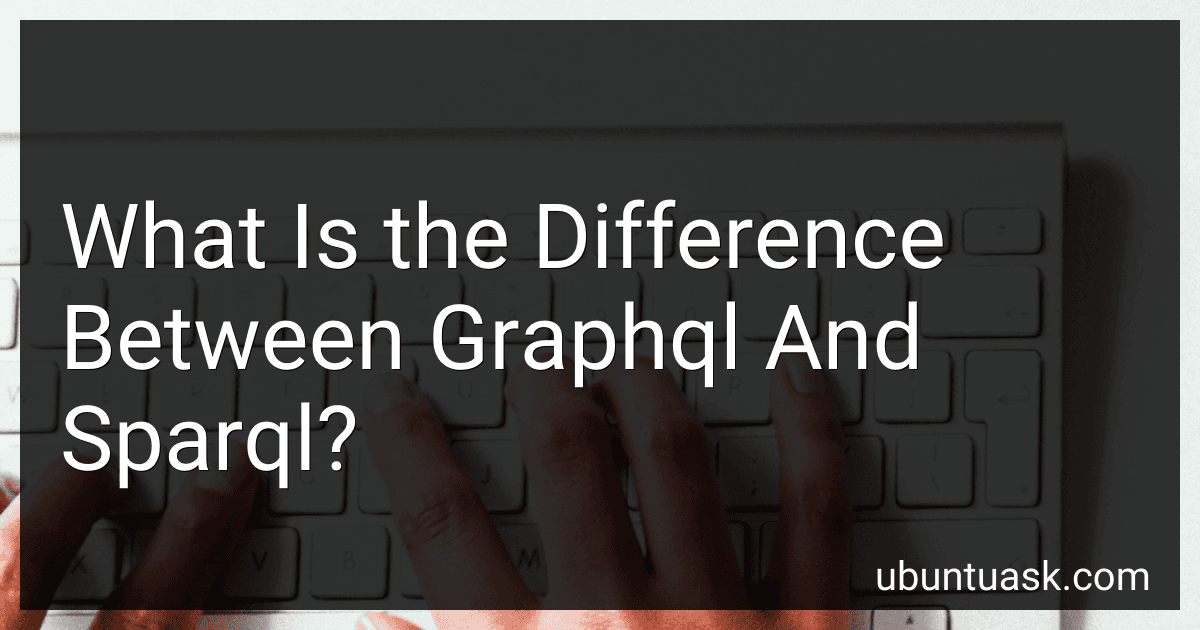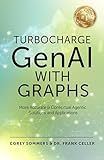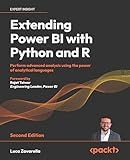Best Graph Query Languages to Buy in December 2025
GraphQL and SPARQL are both query languages used for retrieving data from structured data sources, but they have some key differences.
GraphQL is a query language developed by Facebook that allows clients to request exactly the data they need from a server. It is typically used in web development for client-server communication and provides a more flexible way to query data compared to traditional REST APIs.
SPARQL, on the other hand, is a query language used specifically for querying data stored in RDF (Resource Description Framework) format, which is used for representing data in the Semantic Web. SPARQL is more powerful than GraphQL in terms of querying linked data and making complex queries across multiple datasets.
In summary, GraphQL is more commonly used in web development for querying data from servers, while SPARQL is used for querying linked data in the Semantic Web.
How can one distinguish GraphQL and SPARQL?
GraphQL and SPARQL are both query languages, but they serve different purposes and are used in different contexts. Here are some key distinguishing factors between the two:
- Purpose:
- GraphQL is a query language for APIs, designed to retrieve specific data from a server in a flexible and efficient way. It allows clients to request only the data they need, reducing the amount of data transferred over the network.
- SPARQL, on the other hand, is a query language for querying RDF data sources (such as knowledge graphs or semantic web data). It is specifically designed for querying graph data and expressing complex queries about relationships between entities.
- Data Model:
- GraphQL is based on a hierarchical data model, where data is organized in a graph-like structure of fields and objects. Clients can specify the exact shape of the data they want to receive in a query.
- SPARQL is based on RDF (Resource Description Framework), which represents data as subject-predicate-object triples, forming a directed graph of connected nodes. Queries in SPARQL traverse the graph to retrieve relevant data.
- Usage:
- GraphQL is commonly used in web and mobile applications to fetch and update data from a backend server. It is especially popular for building APIs that serve frontend applications.
- SPARQL is typically used in the context of linked data, semantic web, and knowledge graphs, where complex relationships between entities need to be queried and explored.
In summary, while both GraphQL and SPARQL are query languages, GraphQL is geared towards API development and data fetching in web applications, whereas SPARQL is focused on querying graph data and exploring relationships in linked data sources.
How to differentiate between GraphQL and SPARQL?
- Query Language Purpose: GraphQL is a query language for APIs that allows clients to request only the data they need. It is used to retrieve specific data from a server. SPARQL, on the other hand, is a query language for RDF data that is used to query and retrieve data from Semantic Web databases.
- Data Model: GraphQL is based on a graph-like data model that represents the data in terms of objects and relationships between them. SPARQL is based on the Resource Description Framework (RDF) data model, which represents information in the form of subject-predicate-object triples.
- Usage: GraphQL is typically used in modern web development for querying and retrieving data from APIs, especially in front-end applications. SPARQL is mainly used in the Semantic Web community to query data in RDF format from databases and knowledge graphs.
- Syntax and Structure: GraphQL queries are written in a flexible and human-readable syntax that allows clients to request specific fields and nested data structures. SPARQL queries are written in a more complex and structured syntax that includes keywords like SELECT, WHERE, FILTER, and ORDER BY to retrieve data from RDF graphs.
- Protocol Support: GraphQL is independent of any specific protocol and can be used over HTTP or any other transport mechanism. SPARQL, on the other hand, is typically used over HTTP and supports various query formats such as SPARQL Protocol and RDF Query Language (SPARQL) Protocol, and Results Format (SPARQL-XML, SPARQL-JSON).
By considering these differences, you can effectively differentiate between GraphQL and SPARQL based on their purpose, data model, usage, syntax, and protocol support.
What is the learning curve for developers transitioning from SPARQL to GraphQL?
The learning curve for developers transitioning from SPARQL to GraphQL can vary depending on the developer's prior experience with frontend and backend technologies.
For developers who have experience with relational databases and SQL, SPARQL may be easier to pick up due to its similarity to SQL syntax. However, SPARQL is specifically designed for querying RDF data models and may require developers to learn unique concepts such as triples, graphs, and ontologies.
In contrast, GraphQL is a query language for APIs that allows developers to request only the data they need. Developers transitioning from SPARQL to GraphQL may find that GraphQL is more flexible and easier to work with due to its intuitive syntax and ability to request nested data structures.
Overall, the learning curve for transitioning from SPARQL to GraphQL may be moderate for developers with prior experience in database querying languages. However, developers may need to spend time learning the specific features and nuances of GraphQL in order to effectively use it in their projects.
How to maintain consistency in data retrieval using GraphQL and SPARQL?
To maintain consistency in data retrieval using GraphQL and SPARQL, you can follow these best practices:
- Use a data schema: Define a clear data schema for your GraphQL API that specifies the types of data that can be retrieved and the relationships between them. This will help ensure consistency in how data is structured and accessed.
- Validate input: Ensure that input provided by users follows the defined schema and constraints. Use tools like GraphQL's validation rules to enforce data integrity and prevent inconsistencies in data retrieval.
- Implement caching: Use caching mechanisms to store frequently accessed data and reduce the number of queries to the SPARQL endpoint. This can help improve performance and maintain consistency in data retrieval.
- Use middleware: Implement middleware functions to handle authentication, authorization, and other data processing tasks before retrieving data from the SPARQL endpoint. This can help ensure that only authorized users access the data and maintain consistency in data retrieval.
- Monitor and log errors: Set up monitoring and logging tools to track errors and inconsistencies in data retrieval. This will help you quickly identify and address any issues that may arise in the data retrieval process.
By following these best practices, you can maintain consistency in data retrieval using GraphQL and SPARQL and ensure that your data is accurate and up-to-date.
How to determine when to use GraphQL instead of SPARQL?
- Complexity of data: GraphQL is often preferred when dealing with complex nested data structures, as it allows for more flexible querying of related data. SPARQL, on the other hand, is more suitable for querying structured data and performing complex graph traversal operations.
- Use case: GraphQL is commonly used in web development scenarios where developers may need to fetch a variety of nested data from multiple sources in a single query. SPARQL, on the other hand, is typically used in semantic web applications and data integration scenarios where querying a knowledge graph or RDF dataset is necessary.
- Familiarity and expertise: Consider the expertise of your development team when choosing between GraphQL and SPARQL. If your team is already familiar with GraphQL and has experience developing applications with it, it may be more efficient to use GraphQL. Conversely, if your team has experience with semantic web technologies and querying RDF databases, SPARQL may be a better choice.
- Performance considerations: Depending on the size of your dataset and the complexity of your queries, one query language may perform better than the other. SPARQL is specifically designed for querying RDF datasets and may offer better performance in certain scenarios, while GraphQL may be more flexible but could potentially impact performance when querying large datasets.
- Compatibility with existing systems: Consider how well each query language integrates with your existing systems and data sources. If you are working with RDF data or a triple store, SPARQL may be a better choice. If you are building a modern web application that requires flexible data querying and integration, GraphQL may be more suitable.
Ultimately, the choice between GraphQL and SPARQL will depend on your specific use case, data requirements, and development team expertise. It may also be helpful to consult with experts in both query languages to determine the best fit for your project.




